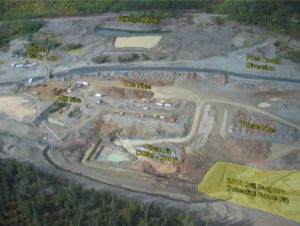African Queen drills 37.1 g/t gold over 1.08 metres

The Yellowjacket gold project near Atlin, northern British Columbia. Source: African Queen Mines Ltd.

African Queen Mines Ltd. [AQ-TSXV; QM0-FSE] has received assay results from the Phase I diamond drilling program on its 100%-owned Yellowjacket gold project located 9 km east of Atlin, northern British Columbia.
In order to investigate continuity of the gold-mineralized zone and expand the historic resource of the Yellowjacket gold mine, four diamond drill holes were designed to target the known Yellowjacket gold-mineralized zone down-dip from the area historically modelled as part
Holes YJ16-01 and 02 were collared from the same pad, with YJ16-01 drilled at a minus-55-degree dip and YJ16-02 at a steeper dip of -75 degrees. Hole YJ16-01 intersected a listwanite altered 3.9-metre-wide faulted zone with elevated gold values up to 3.2 g/t gold over 1.5 metres.
YJ16-02 intersected the mineralized Yellowjacket zone with analyses returning high-grade gold intercepts (8.9 g/t gold over 1.09 metres and 37.1 g/t over 1.08 metres) within broad zones of diverse gold values (0.8 g/t gold over 14.83 metres and 4.1 g/t over 11 metres, respectively).
Widths reported are core widths and do not necessarily represent true widths. Several grains of visible gold within the brecciated fault zone were observed at 74 and 104 metres of depth. Hole YJ16-02 is a 15-metre vertical (downdip) step-out from historic 1988 Homestake drill hole 88-57 which was reported to return 8.06 g/t gold over 12.0 metres, plus 5.58 g/t gold over 6 metres (including two metres of 15.66 g/t gold) and YJ16-01 was a 15-metre updip extension, thereby confirming the continuity of the Yellowjacket mineralization (B.C. Ministry of Mines assessment report No. 18608).
Drill holes YJ16-03 and YJ16-04 were both designed to drill deep below the historically modelled Yellowjacket gold zone, which was previously tested to a depth of 140 metres. Holes YJ16-03 and YJ16-04 were designed to intercept this zone at depths of 250 and 350 metres. Unfortunately, both drill holes were abandoned short of their target depths due to intersecting the clay-rich, highly fractured north fault structure (with hole YJ16-03 ending at 138.68 metres and YJ16-04 ending at 230.12 metres depth). The nature of the underlying fault structure made drilling extremely challenging and excessively costly. The company’s technical team concluded that it would be more effective to target this deeper zone with future drill holes positioned from the south rather than the north in order to bypass this structure. Notwithstanding failure to reach the targeted pay zone, drill hole YJ16-03 intersected 2.7 g/t over 0.92 metre near the bottom of the hole at a depth of approximately 136 metres, indicating mineralized fluid flow along the fault structure presumably originating in the Yellowjacket zone mineralization below. This hole bottomed in the fault structure at 138.68 metres depth.
Historic drilling by previous operators, including Homestake, Muskox Minerals and Prize Mining traced the known Yellowjacket gold-mineralized zone for approximately 300 to 350 metres of strike length along a fault-bounded structure. Within this zone, previous operators have reported numerous drill holes with elevated gold intersections from bedrock surface to a depth of approximately 140 m. The Yellowjacket zone remains open to depth and along strike. With the Yellowjacket mineralization being categorized as a classic mesothermal deposit model, deep drilling remains a highly prospective target for expansion of the gold resource as well as further down-dip drilling. The next phase of diamond drilling will continue to pursue deeper gold intersections by drilling from the south, utilizing different orientations to bypass the complex north fault zone.
According to Irwin Olian, CEO, “The results of our initial four-hole diamond drilling program at the Yellowjacket gold project confirm continuation of the gold-mineralized zone down-dip with several high intersections and other good showings. Although the deep drilling was terminated by a highly fractured clay-rich fault zone which made further drilling not feasible from the northern approach, intersecting deep gold mineralization remains a key target for the next drill phase using different orientations, together with further downdip drilling. In addition, we have now identified nearly a dozen other prospective zones in our extensive regional land package and look forward to exploration drilling to discover new gold-bearing mineralized zones in our Atlin tenures.”
See company website for complete assays at http://www.africanqueenmines.com
